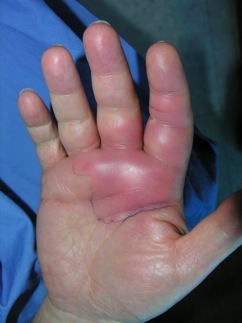 Bites are extremely common and can cause significant pain, damage tissues, and result in infection. Early treatment helps to take care of the injury and prevents future problems. Infections from animal or human bites are caused by bacteria from the mouth; severity of the infection depends on the type and location of the wound, whether you have any medical problems that might make you less able to fight an infection (diabetes, HIV, etc.), delayed treatment, a foreign body (tooth, clothing, etc.) in the wound, and which animal caused the bite. As many as three million animal bites occur in the U.S. each year; 90% of these are from dogs, 5% from cats, 2% from rodents, and the remainder from other animals. Most of these are on fingers of the dominant hand of children ages 5-14. Cat bites are more likely than dog bites to cause infection because they create deep puncture wounds. Six percent of cat bites and one percent of dog bites cause the person to be hospitalized! Thankfully, rabies is rarely caused by domestic animals (house pets) in the U.S. (90% is spread by wild animals like bats, raccoons, skunks, or foxes).
Bites are extremely common and can cause significant pain, damage tissues, and result in infection. Early treatment helps to take care of the injury and prevents future problems. Infections from animal or human bites are caused by bacteria from the mouth; severity of the infection depends on the type and location of the wound, whether you have any medical problems that might make you less able to fight an infection (diabetes, HIV, etc.), delayed treatment, a foreign body (tooth, clothing, etc.) in the wound, and which animal caused the bite. As many as three million animal bites occur in the U.S. each year; 90% of these are from dogs, 5% from cats, 2% from rodents, and the remainder from other animals. Most of these are on fingers of the dominant hand of children ages 5-14. Cat bites are more likely than dog bites to cause infection because they create deep puncture wounds. Six percent of cat bites and one percent of dog bites cause the person to be hospitalized! Thankfully, rabies is rarely caused by domestic animals (house pets) in the U.S. (90% is spread by wild animals like bats, raccoons, skunks, or foxes).
Human bite wounds actually have the highest risk of infection. “Fight bite,” or when a tooth punctures your “knuckle,” can lead to a joint infection that can destroy the cartilage in that joint. Sometimes part of the tooth even stays in the joint. These can require surgery to wash out the joint or remove fragments that should not be there.
 Symptoms and Treatment
Symptoms and Treatment
Concerning symptoms include swelling, redness, warmth, persistent pain, draining pus, red streaks up the arm, swollen "glands," loss of motion or sensation, and "constitutional signs and symptoms" such as fever, night sweats, chills, or feeling super tired or "blah."
If you have any of these symptoms, you should see a doctor. Tell your doctor the story of how you were bitten, including the vaccination status of the animal (if known), when and where it happened, etc. Your doctor will examine the bite and surrounding area. If you have not had a booster shot within ten years, you might need a tetanus shot. X-rays may be used to identify any damage to the bones and joints or tooth fragments that may be embedded.
Treatment includes cleaning of the wound, antibiotics (depending on circumstance), and possibly hospitalization. Certain injuries might require surgery. Follow-up with a hand surgeon to ensure that the infection is clearing or not worrisome and to restore the most function possible.